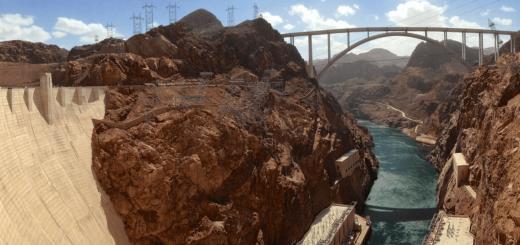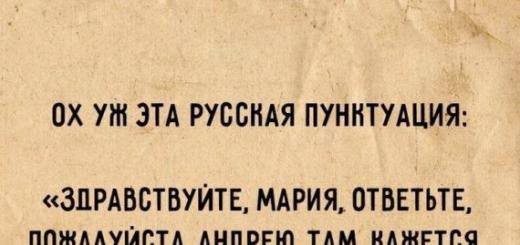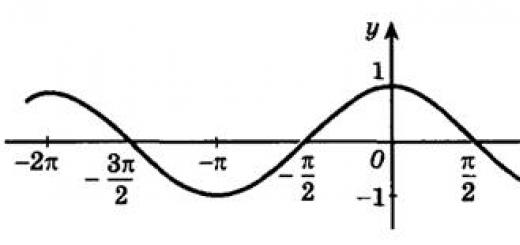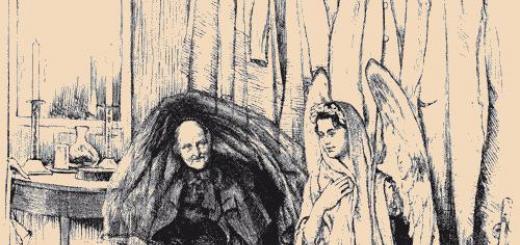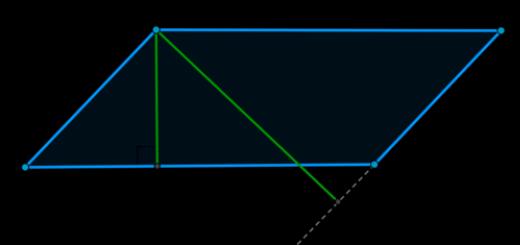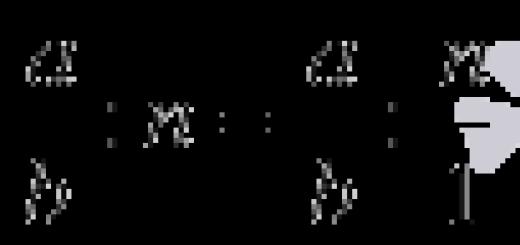1.1. Definition of cylinder 4
1. 3. Sections of the cylinder 8
1.5. Cylinder volume 14
Task 1. 16
Task 2. 16
Task 3. 17
Task 4. 18
Problem 5. 19
Task 6. 20
Problem 7. 21
Problem 8. 22
Task 9. 23
Problem 10. 24
Problem 11. 25
Task 12. 26
Introduction
Stereometry is a branch of geometry that studies shapes in space. The main figures in space are a point, a line and a plane. In stereometry, a new kind of mutual arrangement of lines appears: skew lines. This is one of the few significant differences between solid geometry and planimetry, since in many cases stereometry problems are solved by considering different planes in which planimetric laws are satisfied.
In the nature around us, there are many objects that are physical models of this figure. For example, many machine parts are in the form of a cylinder or some combination of them, and the majestic columns of temples and cathedrals, made in the form of cylinders, emphasize their harmony and beauty.
Greek − kyulindros. ancient term. In everyday life - a papyrus scroll, a roller, a skating rink (verb - twist, roll).
In Euclid, a cylinder is obtained by rotating a rectangle. For Cavalieri - by the movement of the generatrix (with an arbitrary guide - "cylinder").
The purpose of this essay is to consider a geometric body - a cylinder.
To achieve this goal, the following tasks should be considered:
− give definitions of a cylinder;
- consider the elements of the cylinder;
− to study the properties of the cylinder;
- consider the types of section of the cylinder;
- derive the formula for the area of a cylinder;
− derive the formula for the volume of a cylinder;
− solve problems using a cylinder.
1 Theoretical part
1.1. Cylinder definition
Consider some line (curve, broken line or mixed line) l lying in some plane α and some straight line S intersecting this plane. Through all points of the given line l we draw lines parallel to the line S; the surface α formed by these straight lines is called a cylindrical surface. The line l is called the guide of this surface, the lines s 1 , s 2 , s 3 ,... are its generators.
If the guide is a broken line, then such a cylindrical surface consists of a series of flat strips enclosed between pairs of parallel lines, and is called a prismatic surface. The generatrices passing through the vertices of the guiding polyline are called the edges of the prismatic surface, the flat strips between them are called its faces.
If we cut any cylindrical surface with an arbitrary plane that is not parallel to its generators, then we get a line that can also be taken as a guide for this surface. Among the guides, one stands out, which is obtained from the section of the surface by a plane perpendicular to the generators of the surface. Such a section is called a normal section, and the corresponding guide is called a normal guide.
If the guide is a closed (convex) line (broken line or curve), then the corresponding surface is called a closed (convex) prismatic or cylindrical surface. Of the cylindrical surfaces, the simplest has its normal guide circle. Let us dissect a closed convex prismatic surface by two planes parallel to each other, but not parallel to the generators.

In the sections we obtain convex polygons. Now the part of the prismatic surface enclosed between the planes α and α", and the two polygonal plates formed in these planes, limit the body, called the prismatic body - the prism.
A cylindrical body - a cylinder is defined similarly to a prism:
A cylinder is a body bounded laterally by a closed (convex) cylindrical surface, and from the ends by two flat parallel bases. Both bases of the cylinder are equal, and all generators of the cylinder are also equal to each other, i.e. segments forming a cylindrical surface between the planes of the bases.
A cylinder (more precisely, a circular cylinder) is a geometric body, which consists of two circles that do not lie in the same plane and are combined by parallel transfer, and all segments connecting the corresponding points of these circles (Fig. 1).
Rice. 1 − Cylinder
1.2. Elements and properties of a cylinder
The circles are called the bases of the cylinder, and the segments connecting the corresponding points of the circles of the circles are called the generators of the cylinder.
Since parallel translation is motion, the bases of the cylinder are equal.
Since during parallel translation the plane passes into a parallel plane (or into itself), then the bases of the cylinder lie in parallel planes.
Since, during parallel translation, the points are displaced along parallel (or coinciding) lines by the same distance, then the generators of the cylinder are parallel and equal.
The surface of a cylinder consists of bases and a side surface. The lateral surface is composed of generators.
A cylinder is called straight if its generators are perpendicular to the planes of the bases.
A straight cylinder can be visualized as a geometric body that describes a rectangle as it rotates around the side as an axis (Fig. 2).
Rice. 2 − Straight cylinder
In the following, we will consider only a straight cylinder, calling it simply a cylinder for brevity.
The radius of a cylinder is the radius of its base. The height of a cylinder is the distance between the planes of its bases. The axis of a cylinder is a straight line passing through the centers of the bases. It is parallel to the generators.
The cylinder is called equilateral, if its height is equal to the diameter of the base.
If the bases of the cylinder are flat (and hence the planes containing them are parallel), then the cylinder is said to be standing on a plane. If the bases of a cylinder standing on a plane are perpendicular to the generatrix, then the cylinder is called straight.
In particular, if the base of a cylinder standing on a plane is a circle, then one speaks of a circular (round) cylinder; if an ellipse, then elliptical.
1. 3. Sections of the cylinder
The section of the cylinder by a plane parallel to its axis is a rectangle (Fig. 3, a). Two of its sides are generatrices of the cylinder, and the other two are parallel chords of the bases.
Rice. 3 - Sections of the cylinder
In particular, the rectangle is the axial section. This is a section of the cylinder by a plane passing through its axis (Fig. 3, b).
The section of the cylinder by a plane parallel to the base is a circle (Fig. 3, c).
The cross section of the cylinder with a plane not parallel to the base and its axis is an oval (Fig. 3d).
Theorem 1. A plane parallel to the plane of the base of the cylinder intersects its lateral surface along a circle equal to the circumference of the base.
D  proof. Let β be a plane parallel to the plane of the base of the cylinder. Parallel translation in the direction of the axis of the cylinder, which combines the plane β with the plane of the base of the cylinder, combines the section of the side surface by the plane β with the circumference of the base. The theorem has been proven.
proof. Let β be a plane parallel to the plane of the base of the cylinder. Parallel translation in the direction of the axis of the cylinder, which combines the plane β with the plane of the base of the cylinder, combines the section of the side surface by the plane β with the circumference of the base. The theorem has been proven.
1.4. Cylinder area
The area of the lateral surface of the cylinder.
The area of the lateral surface of the cylinder is taken to be the limit to which the lateral surface area of a regular prism inscribed in the cylinder tends when the number of sides of the base of this prism increases indefinitely.
Theorem 2. The area of the lateral surface of the cylinder is equal to the product of the circumference of its base and the height (S side.c = 2πRH, where R is the radius of the base of the cylinder, H is the height of the cylinder).
a)  b)
b) 
Rice. 4 - The area of the lateral surface of the cylinder
Proof.
Let P n and H, respectively, be the perimeter of the base and the height of a regular n-gonal prism inscribed in a cylinder (Fig. 4, a). Then the area of the lateral surface of this prism is S side.c − P n H. Let us assume that the number of sides of the polygon inscribed in the base grows indefinitely (Fig. 4, b). Then the perimeter P n tends to the circumference C = 2πR, where R is the radius of the base of the cylinder, and the height H does not change. Thus, the area of the lateral surface of the prism tends to the limit 2πRH, i.e., the area of the lateral surface of the cylinder is equal to S side.c = 2πRH. The theorem has been proven.
The total surface area of the cylinder.
The total surface area of a cylinder is the sum of the areas of the lateral surface and the two bases. The area of each base of the cylinder is equal to πR 2, therefore, the area of the full surface of the cylinder S full is calculated by the formula S side.c \u003d 2πRH + 2πR 2.
T 1
F 1
a)B) 
Rice. 5 − Full surface area of the cylinder
If the side surface of the cylinder is cut along the generatrix FT (Fig. 5, a) and unfolded so that all the generatrix are in the same plane, then as a result we get a rectangle FTT1F1, which is called the development of the side surface of the cylinder. The side FF1 of the rectangle is a development of the circumference of the base of the cylinder, therefore, FF1=2πR, and its side FT is equal to the generatrix of the cylinder, i.e. FT = H (Fig. 5, b). Thus, the area FT∙FF1=2πRH of the cylinder development is equal to the area of its lateral surface.
Body of rotation called a body formed as a result of the rotation of a line around a straight line.
CYLINDER
A cylinder (circular cylinder) is a body that consists of two circles that do not lie in the same plane and are combined by parallel translation, and all segments connecting the corresponding points of these circles. The circles are called the bases of the cylinder, and the segments connecting the corresponding points of the circles of the circles are called the generators of the cylinder.
Since parallel translation is motion, the bases of the cylinder are equal. Since during parallel transfer the plane passes into a parallel plane, then the bases of the cylinder lie in parallel planes. Since, during parallel translation, the points are displaced along parallel lines by the same distance, the generators of the cylinder are parallel and equal. The surface of a cylinder consists of bases and a side surface.
The radius of a cylinder is the radius of its base. The height of a cylinder is the distance between the planes of its bases. The axis of a cylinder is a straight line passing through the centers of the bases.
A cylinder is called straight if its generators are perpendicular to the planes of the bases. We will consider only a right circular cylinder, calling it simply a cylinder for brevity.
A cylinder can be obtained by rotating a rectangle around one of its sides. The figure shows a cylinder obtained by rotating the rectangle ABCD around the side AB. In this case, the side surface of the cylinder is formed by rotating the side CD, and the base - by rotating the sides BC and AD.
Cylinder sections
1) If the cutting plane passes through the axis of the cylinder, then the section is a rectangle (see figure), two sides of which are generators, and the other two are the diameters of the bases of the cylinder. Such a section is called axial.
cylinder(more precisely, a circular cylinder) is a body that consists of two circles lying in parallel planes and combined by parallel translation, and all segments connecting the corresponding points of these circles. The circles are called cylinder bases, and the segments connecting the corresponding points of the circles are generating.
The cylinder has the following properties, which follow from the fact that the bases of the cylinder are aligned by parallel translation:
1. The bases of the cylinder are equal.
2. The generators of the cylinder are parallel and equal.
The cylinder is called direct if its generators are perpendicular to the planes of the bases. In the following, we will mainly consider straight cylinders, therefore, unless otherwise stated, a cylinder will be understood as a straight cylinder.
Radius A cylinder is called the radius of its base. Height A cylinder is called the distance between the planes of its bases. For a straight cylinder, the height is equal to the generators. axis cylinder is called a straight line passing through the centers of the bases.
The cylinder is a body of revolution, as it can be obtained by rotating a rectangle around its axis.
Tasks
18.1 The height of the cylinder is 6, the radius of the base is 5. The ends of the segment equal to 10 lie on the circles of both bases. Find the shortest distance from this segment to the axis of the cylinder.
18.2 In an equilateral cylinder (the diameter is equal to the height of the cylinder), the point of the circle of the upper base is connected to the point of the circle of the lower base. The angle between the radii drawn to these points is 60 o. Find the angle between the line segment and the axis of the cylinder.
Cone
Cone Definition
cone(more precisely, a circular cone) is a body that consists of a circle - cone base, a point not lying in the plane of the base, - cone apex and all segments connecting the top of the cone with the points of the base. The segments connecting the vertices of the cone with the points of the circumference of the base are called forming a cone.

Cone dwell called the perpendicular dropped from the top of the cone to the plane of the base. If the base of the height coincides with the center of the circle of the base, the cone is called direct. In what follows, by a cone we will usually mean a straight cone.
axis of a right circular cone is called a straight line containing its height. Such a cone can be obtained by rotating a right triangle around one of the legs.
Frustum
A plane parallel to the base of a cone cuts off a similar cone from it. The rest is called truncated cone.

Tasks
19.1 Two generatrices of the cone, resting on the ends of the diameter of the base, make an angle of 60 o between themselves. The radius of the cone is 3. Find the generatrix of the cone and its height.
19.2 A straight line is drawn through the midpoint of the height of the cone, parallel to the generatrix. Find the length of the line segment enclosed inside the cone.
19.3 The generatrix of the cone is 13, the height is 12. The cone is crossed by a straight line parallel to the base; the distance from it to the base is 6, and to the height - 2. Find a straight line segment enclosed inside the cone.
19.4 The radii of the bases of a truncated cone are 3 and 6, the height is 4. Find the generatrix.
Ball definition
ball a body is called, which consists of all points of space located at a distance not greater than a given from some point, called ball center. This distance is called ball radius.

The boundary of the sphere is called spherical surface or sphere. Thus, the points of the sphere are all points of the ball that are at a distance equal to the radius from the center of the ball.
The segment connecting two points of the spherical surface and passing through the center of the ball is called the diameter of the ball.
A ball, like a cylinder and a cone, is a body of revolution. It is obtained by rotating a semicircle around its diameter.
Tasks
20.1 Three points are given on the surface of a sphere. The rectilinear distances between them are 6, 8 and 10. The radius of the ball is 13. Find the distance from the center of the ball to the plane passing through these three points.
20.2 The diameter of a sphere is 25. On its surface, a point and a circle are given, all points of which are removed (in a straight line) from 15. Find the radius of this circle.
20.3 The radius of a sphere is 7. Two circles are given on its surface, having a common chord of length 2. Find the radii of the circles, knowing that their planes are perpendicular.
The name of the science "geometry" is translated as "measurement of the earth." It was born through the efforts of the very first ancient land surveyors. And it happened like this: during the floods of the sacred Nile, streams of water sometimes washed away the boundaries of the plots of farmers, and the new boundaries might not coincide with the old ones. Taxes were paid by the peasants to the treasury of the pharaoh in proportion to the size of the land allotment. After the spill, special people were engaged in measuring the areas of arable land within the new boundaries. It was as a result of their activities that a new science arose, which was developed in ancient Greece. There it received its name, and acquired an almost modern look. In the future, the term became the international name for the science of flat and three-dimensional figures.
Planimetry is a branch of geometry that deals with the study of plane figures. Another branch of science is stereometry, which considers the properties of spatial (volumetric) figures. The cylinder described in this article also belongs to such figures.
There are plenty of examples of the presence of cylindrical objects in everyday life. Almost all parts of rotation - shafts, bushings, necks, axles, etc. have a cylindrical (much less often - conical) shape. The cylinder is widely used in construction: towers, supporting, decorative columns. And besides, dishes, some types of packaging, pipes of various diameters. And finally - the famous hats, which have become a symbol of male elegance for a long time. The list is endless.
Definition of a cylinder as a geometric figure
A cylinder (circular cylinder) is usually called a figure consisting of two circles, which, if desired, are combined using parallel translation. It is these circles that are the bases of the cylinder. But the lines (straight segments) connecting the corresponding points are called "generators".
It is important that the bases of the cylinder are always equal (if this condition is not met, then we have a truncated cone in front of us, something else, but not a cylinder) and are in parallel planes. The segments connecting the corresponding points on the circles are parallel and equal.
The totality of an infinite set of generators is nothing more than the lateral surface of a cylinder - one of the elements of a given geometric figure. Its other important component is the circles discussed above. They are called bases.
Types of cylinders
The simplest and most common type of cylinder is circular. It is formed by two regular circles acting as bases. But instead of them there may be other figures.

The bases of the cylinders can form (except for circles) ellipses and other closed figures. But the cylinder may not necessarily have a closed shape. For example, a parabola, a hyperbola, or another open function can serve as the base of a cylinder. Such a cylinder will be open or deployed.
According to the angle of inclination of the generatrices to the bases, the cylinders can be straight or inclined. For a right cylinder, the generators are strictly perpendicular to the plane of the base. If this angle differs from 90°, the cylinder is inclined.

What is a surface of revolution
A right circular cylinder is without a doubt the most common surface of revolution used in engineering. Sometimes, according to technical indications, conical, spherical, and some other types of surfaces are used, but 99% of all rotating shafts, axles, etc. made in the form of cylinders. In order to better understand what a surface of revolution is, we can consider how the cylinder itself is formed.
Let's say there is a line a placed vertically. ABCD is a rectangle, one of whose sides (segment AB) lies on a straight line a. If we rotate a rectangle around a straight line, as shown in the figure, the volume that it will occupy while rotating will be our body of revolution - a right circular cylinder with height H = AB = DC and radius R = AD = BC.

In this case, as a result of the rotation of the figure - a rectangle - a cylinder is obtained. Rotating a triangle, you can get a cone, rotating a semicircle - a ball, etc.
Cylinder surface area
In order to calculate the surface area of an ordinary straight circular cylinder, it is necessary to calculate the areas of the bases and the lateral surface.

First, let's look at how the lateral surface area is calculated. This is the product of the circumference and the height of the cylinder. The circumference, in turn, is equal to twice the product of the universal number P to the radius of the circle.
The area of a circle is known to be equal to the product P to the square of the radius. So, adding the formulas for the area of determining the lateral surface with twice the expression for the area of the base (there are two of them) and making simple algebraic transformations, we obtain the final expression for determining the surface area of \u200b\u200bthe cylinder.
Determining the volume of a figure
The volume of a cylinder is determined by the standard scheme: the surface area of the base is multiplied by the height.

Thus, the final formula looks like this: the desired is defined as the product of the height of the body by the universal number P and the square of the base radius.
The resulting formula, it must be said, is applicable to solving the most unexpected problems. In the same way as the volume of a cylinder, for example, the volume of electrical wiring is determined. This may be necessary to calculate the mass of wires.

The only difference in the formula is that instead of the radius of one cylinder, there is the diameter of the wiring core divided in two and the number of cores in the wire appears in the expression N. Also, wire length is used instead of height. Thus, the volume of the “cylinder” is calculated not by one, but by the number of wires in the braid.
Such calculations are often required in practice. After all, a significant part of the water tanks is made in the form of a pipe. And it is often necessary to calculate the volume of a cylinder even in the household.
However, as already mentioned, the shape of the cylinder can be different. And in some cases it is required to calculate what the volume of the inclined cylinder is equal to.
The difference is that the surface area of the base is multiplied not by the length of the generatrix, as in the case of a straight cylinder, but by the distance between the planes - a perpendicular segment built between them.

As can be seen from the figure, such a segment is equal to the product of the length of the generatrix by the sine of the angle of inclination of the generatrix to the plane.
How to build a cylinder sweep
In some cases, it is required to cut out a cylinder reamer. The figure below shows the rules by which a blank is built for the manufacture of a cylinder with a given height and diameter.

Please note that the figure is shown without seams.
Beveled Cylinder Differences

Let us imagine a straight cylinder bounded on one side by a plane perpendicular to the generators. But the plane bounding the cylinder on the other side is not perpendicular to the generators and is not parallel to the first plane.

The figure shows a beveled cylinder. Plane a at some angle other than 90° to the generators, intersects the figure.
This geometric shape is more common in practice in the form of pipeline connections (elbows). But there are even buildings built in the form of a beveled cylinder.
Geometric characteristics of the beveled cylinder

The slope of one of the planes of the beveled cylinder slightly changes the order of calculation of both the surface area of such a figure and its volume.
kylindros, roller, roller) - a geometric body bounded by a cylindrical surface (called the side surface of the cylinder) and no more than two surfaces (cylinder bases); moreover, if there are two bases, then one is obtained from the other by parallel transfer along the generatrix of the lateral surface of the cylinder; and the base intersects each generatrix of the lateral surface exactly once.An infinite body bounded by a closed infinite cylindrical surface is called endless cylinder, bounded by a closed cylindrical ray and its base, is called open cylinder. The base and generators of a cylindrical beam are called the base and generators of an open cylinder, respectively.
A finite body bounded by a closed finite cylindrical surface and two sections that separate it is called final cylinder, or actually cylinder. The sections are called the bases of the cylinder. By definition of a finite cylindrical surface, the bases of a cylinder are equal.
Obviously, the generators of the lateral surface of the cylinder are equal in length (called tall cylinder) segments lying on parallel lines, and with their ends lying on the bases of the cylinder. Mathematical curiosities include the definition of any finite three-dimensional surface without self-intersections as a zero-height cylinder (this surface is considered simultaneously by both bases of the finite cylinder). The bases of the cylinder qualitatively affect the cylinder.
If the bases of the cylinder are flat (and hence the planes containing them are parallel), then the cylinder is called standing on the plane. If the bases of a cylinder standing on a plane are perpendicular to the generatrix, then the cylinder is called straight.
In particular, if the base of a cylinder standing on a plane is a circle, then one speaks of a circular (round) cylinder; if an ellipse - then elliptical.
The volume of the final cylinder is equal to the integral of the base area along the generatrix. In particular, the volume of a right circular cylinder is
(where is the radius of the base, is the height).
The lateral surface area of a cylinder is calculated using the following formula:
The total surface area of a cylinder is the sum of the lateral surface area and the area of the bases. For a straight circular cylinder:
Wikimedia Foundation. 2010 .
See what "Cylinder (geometry)" is in other dictionaries:
A branch of mathematics that studies the properties of various shapes (points, lines, angles, two-dimensional and three-dimensional objects), their size and relative position. For the convenience of teaching, geometry is divided into planimetry and solid geometry. AT… … Collier Encyclopedia
- (γήμετρώ earth, μετρώ measure). The concepts of space, position and form are among the original, with which man was already familiar in ancient times. The first steps in Georgia were made by the Egyptians and the Chaldeans. In Greece, G. was introduced ... ... Encyclopedic Dictionary F.A. Brockhaus and I.A. Efron
FREE SURFACE GEOMETRY- the shape of the free surface, formed under the action of gravity and centrifugal force during the rotation of the liquid metal around the axis of rotation. With a horizontal axis of rotation, the free surface is a circular cylinder, with a vertical ... Metallurgical Dictionary
A section of geometry in which geometric images are studied by methods of mathematical analysis. The main objects of DG are arbitrary sufficiently smooth curves (lines) and surfaces of Euclidean space, as well as families of lines and ...
This term has other meanings, see Pyramidatsu (meanings). The reliability of this section of the article has been questioned. It is necessary to verify the accuracy of the facts stated in this section. There may be explanations on the talk page ... Wikipedia
A theory that studies external geometry and the relationship between external and internal. geometry of submanifolds of Euclidean or Riemannian space. P. m. g. is a generalization of the classic. differential geometry of surfaces in Euclidean space. ... ... Mathematical Encyclopedia
Cartesian coordinate system Analytic geometry section of geometry in which ... Wikipedia
Section of geometry, in which geometrical are studied. images, primarily curves and surfaces, by mathematical methods. analysis. Usually in DGs the properties of curves and surfaces are studied in the small, that is, the properties of arbitrarily small pieces of them. Besides, in … Mathematical Encyclopedia
This term has other meanings, see Scope (meanings). Volume is an additive function of a set (measure) that characterizes the capacity of a region of space that it occupies. Initially, it arose and was applied without strict ... ... Wikipedia
A part of geometry included in elementary mathematics (See elementary mathematics). The boundaries of egalitarianism, as well as of elementary mathematics in general, are not strictly delineated. They say that E. g. is that part of geometry that is studied in ... ... Great Soviet Encyclopedia
Books
- Cheerful geometry for the little ones, Timofeevsky Alexander Pavlovich. A new book by a wonderful poet, author of the well-known Song of the Crocodile Gena Alexander Timofeevsky with vivid illustrations by Leonid Shmelkov in a playful way introduces kids to the main ...
